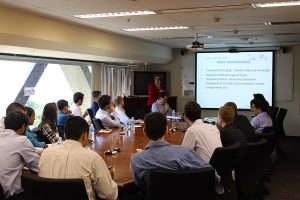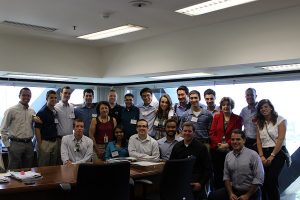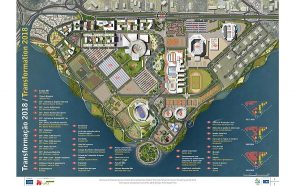
Day one of our New York trip finished with the massive Hudson Yards Development. This multi-billion dollar development includes multiple high-rises to house 13 million square feet of residential, commercial and offices along with a cultural center, public school and green space. If that wasn’t complicated enough, all of this must be built on a $750 million platform over a 30-line rail yard that will not cease operation for the duration of the project. Our meeting took place in a non-descript office on West 33rd street, directly across from the job site. Nick Mazzaferro, the owner’s representative for developer Related Companies, along with Terry Flynn and Jay Gold, project managers for contractor Tutor-Perini met with us for the afternoon. They quickly scrapped the planned presentation to instead answer our questions for two hours and then gave us a site tour. These three have had many years of experience in the New York Construction industry and displayed a wide scope of knowledge seeming to leave no question unanswered.

The site for the Hudson Yards development is the last undeveloped plot of land in Manhattan. It is a rail yard owned and operated by New York’s Metropolitan Transit Authority (MTA). The yard is used every day to park, clean and service trains that bring commuters into and out of the city. The site has been plagued for years as several projects have fallen through due to site complications, funding issues, the recession, politics, shifting public opinion, loss of the Olympic bid and zoning requirements. After three or four years of complicated and political Environmental Impact Statements (EIS) and zoning changes, Related Companies is moving forward with the project. Some were surprised to hear of the strict zoning requirements including a cultural center and public school for a private sector project to which Mazzaferro responded, “That’s New York for you.” Related sought Mazzaferro out to work as owner’s representative on the project due to his many years of experience working for the Long Island Rail Road, a subsidiary company of the MTA. Using a Design-Build delivery system, they hired Tutor-Perini to construct the development on land leased from the MTA. The deal is the largest real estate transaction and most profitable activity for the MTA ever. Tutor-Perini was hired both on the basis of value and relationship from finishing a successful project with Related in Las Vegas. Currently, they are beginning tower C which will be located off the platform and are finishing the structural designs for the platform.

Mr. Mazzaferro’s presentation focused on the challenges of constructing over an operating rail yard. Tutor-Perini will have a four-year period during which they may shut down any 4 parking lines, and, for one weekend only, 2 of 4 throat lines that lead into the rail yard. Liquidated damages can be as high as $500 for every minute the lines are closed beyond the permissible time. Under these and other restrictions, the platform will be constructed on 320 concrete caissons drilled to bedrock. Steel ingots will be placed and the caissons, then 16” thick prefabricated concrete slabs will span the ingots. The design is being modified to eliminate the need for 50 new caissons as it was realized that part of the structure could stand on 50 existing caissons that were installed in the 1980’s for a project that was never built over the yard. Another challenge due to the operational rail yard is the ventilation beneath the platform. Though the rail yard will not be closed in on the sides, a massive ventilation system will be required to manage appropriate working environment temperatures due to the heat generated by the trains. Engineers developed a computer model for the air ventilation beneath the platform which takes seven days to run once.

One of the biggest takeaways for us was observing the need for strategic planning and management when constructing over operating facilities. This is even more important as we got a taste for the political, social and structural complexities of construction in dense urban areas like New York. But perhaps most simply, we took away an appreciation for the massive scale ($6 Billion) and complexity of the development. That being said, we left with a confidence that this project will be completed successfully due to the Related and Tutor-Perini’s mutual commitment to each other’s success; a critical characteristic for Design-Build projects. We look forward to following the progress and eventual completion of the Hudson Yards Development, which is touted by some as capable of “[capturing] the heart of New York” (ENR, online).
